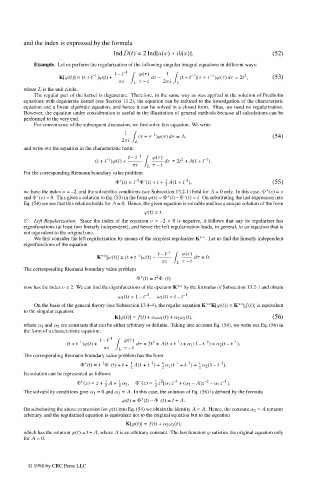Page 674 - Handbook Of Integral Equations
P. 674
and the index is expressed by the formula
Ind D(t) = 2 Ind[a(x)+ ib(x)]. (52)
Example. Let us perform the regularization of the following singular integral equations in different ways:
t – t –1 ϕ(τ) 1
–1
–1
–1
2
K[ϕ(t)] ≡ (t + t )ϕ(t)+ dτ – (t + t )(τ + τ )ϕ(τ) dτ =2t , (53)
πi L τ – t 2πi L
where L is the unit circle.
The regular part of the kernel is degenerate. Therefore, in the same way as was applied in the solution of Fredholm
equations with degenerate kernel (see Section 11.2), the equation can be reduced to the investigation of the characteristic
equation and a linear algebraic equation, and hence it can be solved in a closed form. Thus, we need no regularization.
However, the equation under consideration is useful in the illustration of general methods because all calculations can be
performed to the very end.
For convenience of the subsequent discussion, we first solve this equation. We write
1
–1
(τ + τ )ϕ(τ) dτ = A, (54)
2πi L
and write out the equation in the characteristic form:
t – t –1 ϕ(τ)
–1
–1
2
(t + t )ϕ(t)+ dτ =2t + A(t + t ).
πi L τ – t
For the corresponding Riemann boundary value problem
+
–2
–2
–
Φ (t)= t Φ (t)+ t + 1 A(1 + t ), (55)
2
+
we have the index ν = –2, and the solvability conditions (see Subsection 13.2-1) hold for A = 0 only. In this case, Φ (z)= z
+
–
–
and Φ (z) = 0. This gives a solution to Eq. (53) in the form ϕ(t)= Φ (t) – Φ (t)= t. On substituting the last expression into
Eq. (54) we see that this relation holds for A = 0. Hence, the given equation is solvable and has a unique solution of the form
ϕ(t)= t.
1 . Left Regularization. Since the index of the equation ν = –2 < 0 is negative, it follows that any its regularizer has
◦
eigenfunctions (at least two linearly independent), and hence the left regularization leads, in general, to an equation that is
not equivalent to the original one.
We first consider the left regularization by means of the simplest regularizer K ∗◦ . Let us find the linearly independent
eigenfunctions of the equation
t – t –1 ω(τ)
–1
K ∗◦ [ω(t)] ≡ (t + t )ω(t) – dτ =0.
πi L τ – t
The corresponding Riemann boundary value problem
2
–
+
Φ (t)= t Φ (t)
now has the index ν = 2. We can find the eigenfunctions of the operator K ∗◦ by the formulas of Subsection 13.2-1 and obtain
–1
–2
ω 1 (t)=1 – t , ω 2 (t)= t – t .
On the basis of the general theory (see Subsection 13.4-4), the regular equation K ∗◦ K[ϕ(t)] = K ∗◦ [f(t)] is equivalent
to the singular equation:
K[ϕ(t)] = f(t)+ α 1 ω 1 (t)+ α 2 ω 2 (t), (56)
where α 1 and α 2 are constants that can be either arbitrary or definite. Taking into account Eq. (54), we write out Eq. (56) in
the form of a characteristic equation:
t – t –1 ϕ(τ)
–1
2
–2
–1
–1
(t + t )ϕ(t)+ dτ =2t + A(t + t )+ α 1 (1 – t )+ α 2 (t – t ).
πi L τ – t
The corresponding Riemann boundary value problem has the form
–2
–3
–
–2
–2
+
Φ (t)= t Φ (t)+ t + 1 A(1 + t )+ 1 α 1 (t –1 + t )+ 1 α 2 (1 – t ).
2 2 2
Its solution can be represented as follows:
–1
+
–
Φ (z)= z + 1 A + 1 α 2 , Φ (z)= 1 2 –3 +(α 2 – A)z –2 – α 1 z ].
z [α 1 z
2 2 2
The solvability conditions give α 1 = 0 and α 2 = A. In this case, the solution of Eq. (56) is defined by the formula
+
–
ϕ(t)= Φ (t) – Φ (t)= t + A.
On substituting the above expression for ϕ(t) into Eq. (54) we obtain the identity A = A. Hence, the constant α 2 = A remains
arbitrary, and the regularized equation is equivalent not to the original equation but to the equation
K[ϕ(t)] = f(t)+ α 2 ω 2 (t),
which has the solution ϕ(t)= t + A, where A is an arbitrary constant. The last function ϕ satisfies the original equation only
for A =0.
© 1998 by CRC Press LLC
© 1998 by CRC Press LLC
Page 657

